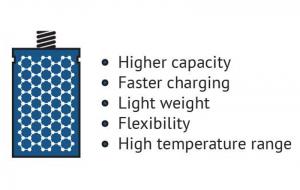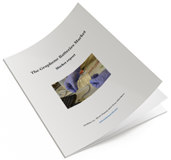Graphene batteries: Introduction and Market News - Page 16
Taiwan's Fubon leads $64 million investment round in Nanotech Energy
Fubon Financial Holding, a Taiwan-based financial services business led by the Tsai family, has led a $64 million investment round in U.S. battery maker Nanotech Energy.
The U.S-based graphene materials supplier and graphene-enhanced batteries developer, Nanotech Energy, will use the new Series D funding to build a graphene battery manufacturing facility in Reno, Nevada and open an European headquarters in Amsterdam. The Reno facility is reportedly due to open in the second half of 2022. Nanotech Energy also plans to increase capacity in its current Chico, California factory for graphene itself, graphene-based conductive inks, adhesives, shielding and silver nanowires.
Gnanomat's materials display positive performance as catalysts in secondary zinc air batteries
Gnanomat’s advanced materials were reportedly confirmed as competitive bifunctional catalysts in the air electrode of Secondary Zinc-air batteries (SZAB).
The tests carried out in SZAB prototypes using Gnanomat´s advanced materials as bifunctional catalysts for the air electrode showed outstanding performance in charge and discharge modes. In addition, the tests performed in prototype cells also showed great stability and cyclability, addressing one of the most challenging drawbacks of this technology.
Vaulta secures Federal government grant
Australia-based battery case developer Vaulta has been awarded a Federal Government grant to commercialize its battery casings for the electric vehicle market.
Vaulta received a grant of AUD$297,500 (around USD$219,000) from the Federal Government’s Accelerating Commercialization grants program to commercialize its low-cost and light-weight graphene-enhanced battery modules.
GMG announces in-house battery pilot plant investment
Graphene Manufacturing Group (GMG) has announced that it is procuring equipment for a pilot production and testing plant for the manufacture of its Graphene Aluminum-Ion Batteries.
Following recently published performance results and encouraging customer feedback, production of a commercial prototype coin cell battery is targeted before the end of 2021. This pilot production and testing plant is an important next step in the Company’s battery technology development plan.
Are graphene batteries finally getting closer to commercialization?
Batteries have always been a highly sought-after application for graphene materials, bearing promises of expanded capacity, ultra-fast charging, improved safety of use and more.
 Early testing in labs and research institutes were very promising, but the move from lab to market proved more challenging than people expected. Even today, in 2021, graphene batteries aren't on the market yet, in any major way.
Early testing in labs and research institutes were very promising, but the move from lab to market proved more challenging than people expected. Even today, in 2021, graphene batteries aren't on the market yet, in any major way.
We do see, however, some niche adoption - for example, the use of graphene to enable novel battery casings, or extending the battery's temperature range (see Huawei's 2016 graphene battery announcement for example). But actual graphene-enhanced battery anodes or other components haven't been realized yet.
Lithium Energy to pursue commercial lithium-ion battery opportunities for its graphene
Lithium Energy, an emerging battery minerals company with two exploration and development projects (the Solaroz Lithium Project in Argentina and the Burke Graphite Project in Queensland), has announced its plans to pursue commercial opportunities for using its graphene in lithium-ion batteries
Testing by the Company has reportedly confirmed its Burke Deposit is well suited for graphene production via electrochemical exfoliation process, via a relatively low cost and environmentally friendly process that produces very high purity graphene products.
Graphene-Info updates all its graphene market report
Today we published new versions of all our graphene market reports. Graphene-Info provides comprehensive niche graphene market reports, and our reports cover everything you need to know about these niche markets. The reports are now updated to July 2021.
The Graphene Batteries Market Report:
- The advantages using graphene batteries
- The different ways graphene can be used in batteries
- Various types of graphene materials
- What's on the market today
- Detailed specifications of some graphene-enhanced anode material
- Personal contact details into most graphene developers
The report package provides a good introduction to the graphene battery - present and future. It includes a list of all graphene companies involved with batteries and gives detailed specifications of some graphene-enhanced anode materials and contact details into most graphene developers. Read more here!
KAUST team develops graphene-based method to make improved lithium-sulfur batteries
KAUST researchers have found that a layer of hierarchically three-dimensional porous graphene can greatly suppress polysulfide shuttling - a problem known to be holding back the development of lithium-sulfur batteries. This could potentially help create high-density batteries that are useful for various applications, like electric vehicles and more.

Li-S batteries have several potential advantages over the most commonly used types of batteries. They have a higher theoretical energy storage capacity and sulfur is a nontoxic element readily available in nature. Sulfur is also a waste product of the petrochemical industry, so it could be obtained relatively cheaply while increasing the sustainability of another industry.
GMG joins Future Battery Industry Cooperative Research Centre
Graphene Manufacturing Group (GMG) has announced that it will join the Future Battery Industries Cooperative Research Centre (CRC) for battery electrolytes development along with various organizations and universities.
The CRC’s objective is to develop advanced electrolyte systems that improve battery performance. The project will run over a period of 4 years with GMG providing a source of graphene and personnel time to the project.
GMG shares further updates on aluminum-ion coin cell batteries performance
Australia-based Graphene Manufacturing Group (GMG) recently shared initial performance data from tests performed on coin cells for the patent-pending surface perforation of graphene in aluminium-ion batteries developed by the Company and the University of Queensland (UQ). Now, GMG revealed further performance data of these graphene aluminium-ion coin cell batteries.
 Source: University of Queensland, GMG website
Source: University of Queensland, GMG website
The experiments were performed at the Australian Institute for Bioengineering and Nanotechnology (AIBN) at UQ. Testing reportedly confirmed a very high cycle rate for graphene aluminium-ion coin cell batteries together with minimal reduction in performance over a 3,000 cycle experiment period (which includes charging up to full charge and discharge down to near full discharge) at very high charging rates including at 2 Ampere per gram (A/g) of cathode material for 1000 cycles, 5 A/g of cathode material for 1000 cycles and then 10 A/g of cathode material for a further 1000 cycles.
Pagination
- Previous page
- Page 16
- Next page


